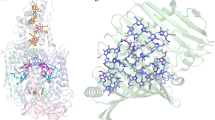Abstract
Analysis of lumiflavin triplet-state decay kinetics in aqueous solution has given the following results:k 1 (first-order decay)=670 sec−1,k 2 (triplet-triplet quenching)=8·9×108 M−1 sec−1,k 3 (triplet-ground-state quenching)=3·7×108 M−1 sec−1. The FMN triplet decays mainly via intramolecular quenching by the ribityl side chain and triplet-groundstate quenching. Ferricyanide and phenols are shown to be excellent quenchers of the flavin triplet (comparable to KI and O2). In the case of phenols, quenching occurs via hydroxyl hydrogen abstraction to generate flavin radical and phenoxy radical. Recombination of these radicals (by reverse hydrogen transfer) competes effectively with flavin radical disproportionation. The lumiflavin triplet is also able to abstract hydrogen from a ground state lumiflavin molecule (probably from the 10-methyl group). The radicals so generated can either recombine or undergo a buffer-catalyzed reaction leading to permanent bleaching. Evidence is presented for rapid oxidation of lumiflavin radical by both oxygen and ferricyanide. In dry non-polar solvents, lumiflavin triplet formation is prevented; addition of small amounts of water restores the ability to produce triplet state molecules. This is probably due to an effect of water on intersystem crossing.
Similar content being viewed by others
References
For a recent review, see G. R. Penzer and G. K. Radda,Quart. Rev.,21 (1967) 43.
W. R. Briggs, in: Photophysiology, A. C. Giese (ed.), Academic Press, New York, 1964, vol. I, pp. 249–259.
G. Tollin and M. I. Robinson,Photochem. Photobiol.,9 (1969) 411.
B. Diehn,Biochim. Biophys. Acta,177 (1969) 136.
W. Haupt and I. Schönfeld,Ber. Deutsch. Bot. Ges.,75 (1962) 14.
Cf. M. Green and G. Tollin,Photochem. Photobiol.,7 (1968) 145, and references cited therein.
L. Tegner and B. Holmström,Photochem. Photobiol.,5 (1966) 223.
J. M. Lhoste, A. Haug, and P. Hemmerich,Biochem.,5 (1966) 3290.
A. V. Guzzo and G. Tollin,Arch. Biochem. Biophys.,103 (1963) 231.
A. Knowles and E. M. F. Roe,Photochem. Photobiol.,7 (1968) 421.
E. J. Land and A. J. Swallow,Biochem.,8 (1969) 2117.
H. Linschitz and K. Sarkanen,J. Am. Chem. Soc.,80 (1958) 4826.
E. J. Land, G. Porter and E. Strachan,Trans. Faraday Soc.,57 (1961) 1885.
N. Getoff and G. O. Schenck,Photochem. Photobiol.,8 (1968) 167.
J. Koziol,Photochem. Photobiol.,5 (1966) 41.
Author information
Authors and Affiliations
Rights and permissions
About this article
Cite this article
Vaish, S.P., Tollin, G. Flash photolysis of flavins. IV. Some properties of the lumiflavin triplet state. J Bioenerg Biomembr 1, 181–192 (1970). https://doi.org/10.1007/BF01515980
Issue Date:
DOI: https://doi.org/10.1007/BF01515980




